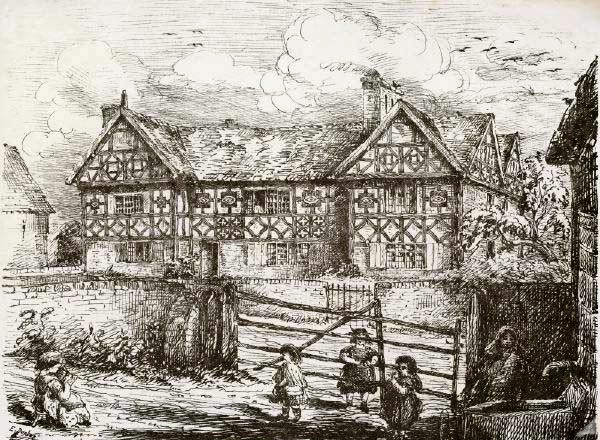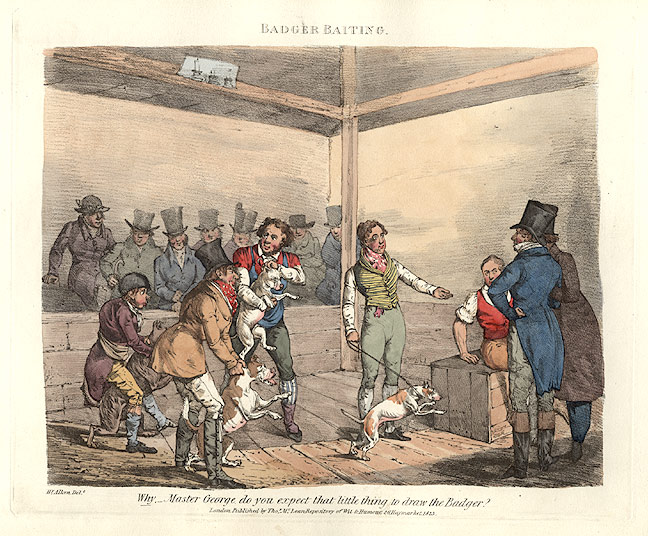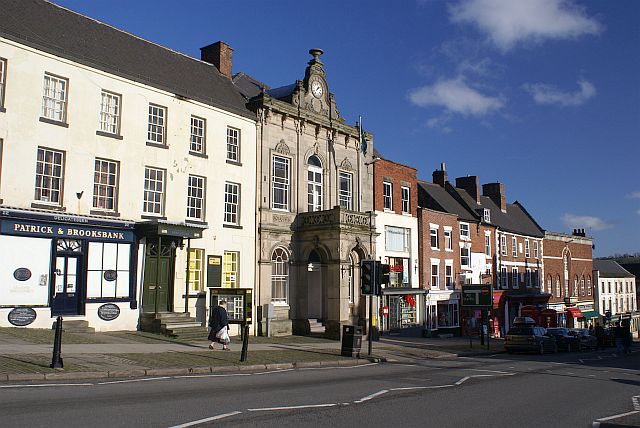|
Tutbury Bull Run
The Tutbury bull run was a blood sport that took place in Tutbury, Staffordshire, from the 14th century until 1778. It formed part of the annual Court of Minstrels, a ceremonial legal proceeding for travelling musicians in the nearby counties. The Tutbury bull run is first recorded in 1414 but may be of earlier origin, though a story that it was begun by John of Gaunt to remind his Spanish wife of home is believed false. The bull was provided to the minstrels by Tutbury Priory and, after the Dissolution of the Monasteries, by the Duke of Devonshire. The bull would be chased through the town by the minstrels who could claim it if it was caught. It was afterwards baited to death and served in a feast. The event developed into a competition between Staffordshire and Derbyshire residents who competed to catch the bull within their own counties. After the decline of the Court of Minstrels the bull run developed into a drunken revel. It was abolished in 1778 after a man was k ... [...More Info...] [...Related Items...] OR: [Wikipedia] [Google] [Baidu] |
Bull Running
Bull running was a custom practised in England until the 19th century. It involved chasing a bull through the streets of a town until it was weakened, then slaughtering the animal and butchering it for its meat. Bull running became illegal in 1835, and the last bull run took place in Stamford, Lincolnshire, in 1839. The practice was not confined to any particular region, with bull runs also documented at Axbridge in the South West England, south west, Canterbury and Wokingham in the South East England, south east, Tutbury in the West Midlands (region), midlands, and Wisbech in the East of England, east. The origins of the custom are uncertain, and the date of observance varied across the country. In Stamford, the bull run took place on Brice of Tours, St Brice's Day (13 November); in Tutbury, it was held on the Assumption of Mary, Feast of the Assumption (15 August); and in Axbridge on Guy Fawkes Day (5 November). Participants may be referred to as bullards, as in the Bullards' Son ... [...More Info...] [...Related Items...] OR: [Wikipedia] [Google] [Baidu] |
Hilton, Derbyshire
Hilton is a village and civil parish in the South Derbyshire district of Derbyshire, England. The population at the 2011 Census (including Marston on Dove) was 7,714. History Hilton was mentioned in the Domesday Book in 1086 as belonging to Henry de FerrersHenry was given a large number of manors in Derbyshire including Doveridge, Linton, Pilsbury and Cowley. and being worth ten shillings.''Domesday Book: A Complete Translation''. London: Penguin, 2003. p.747 It was later held by Dale Abbey. After the dissolution of the monasteries, the manor passed to the Earl of Chesterfield, and later to the Every baronets. Wakelyn Hall is a Grade II listed half-timbered building dating back to the 16th century. Mary, Queen of Scots allegedly stopped at Wakelyn Hall briefly on her way to imprisonment at Tutbury Castle. Other historic buildings include the Old Talbot Inn, the Wesleyan Chapel and Hilton Lodge. Hilton was the birthplace of Herbert Massey who authorised the Great Escape. H ... [...More Info...] [...Related Items...] OR: [Wikipedia] [Google] [Baidu] |
August Events
August is the eighth month of the year in the Julian and Gregorian calendars, and the fifth of seven months to have a length of 31 days. Its zodiac sign is Leo and was originally named ''Sextilis'' in Latin because it was the 6th month in the original ten-month Roman calendar under Romulus in 753 BC, with March being the first month of the year. About 700 BC, it became the eighth month when January and February were added to the year before March by King Numa Pompilius, who also gave it 29 days. Julius Caesar added two days when he created the Julian calendar in 46 BC (708 AUC), giving it its modern length of 31 days. In 8 BC, it was renamed in honor of Emperor Augustus. According to a Senatus consultum quoted by Macrobius, he chose this month because it was the time of several of his great triumphs, including the conquest of Egypt. Commonly repeated lore has it that August has 31 days because Augustus wanted his month to match the length of Julius Caesar's July, but t ... [...More Info...] [...Related Items...] OR: [Wikipedia] [Google] [Baidu] |
Defunct Sporting Events
{{Disambiguation ...
Defunct (no longer in use or active) may refer to: * ''Defunct'' (video game), 2014 * Zombie process or defunct process, in Unix-like operating systems See also * * :Former entities * End-of-life product * Obsolescence Obsolescence is the state of being which occurs when an object, service, or practice is no longer maintained or required even though it may still be in good working order. It usually happens when something that is more efficient or less risky r ... [...More Info...] [...Related Items...] OR: [Wikipedia] [Google] [Baidu] |
Annual Events In England , in biology
{{disambiguation ...
Annual may refer to: *Annual publication, periodical publications appearing regularly once per year **Yearbook **Literary annual *Annual plant *Annual report *Annual giving *Annual, Morocco, a settlement in northeastern Morocco *Annuals (band), a musical group See also * Annual Review (other) * Circannual cycle A circannual cycle is a biological process that occurs in living creatures over the period of approximately one year. This cycle was first discovered by Ebo Gwinner and Canadian biologist Ted Pengelley. It is classified as an Infradian rhythm, whi ... [...More Info...] [...Related Items...] OR: [Wikipedia] [Google] [Baidu] |
1778 Disestablishments In England
Events January–March * January 18 – Third voyage of James Cook: Captain James Cook, with ships HMS ''Resolution'' and HMS ''Discovery'', first views Oahu then Kauai in the Hawaiian Islands of the Pacific Ocean, which he names the ''Sandwich Islands''. * February 5 – **South Carolina becomes the first state to ratify the Articles of Confederation. ** **General John Cadwalader shoots and seriously wounds Major General Thomas Conway in a duel after a dispute between the two officers over Conway's continued criticism of General George Washington's leadership of the Continental Army.''Harper's Encyclopaedia of United States History from 458 A. D. to 1909'', ed. by Benson John Lossing and, Woodrow Wilson (Harper & Brothers, 1910) p166 * February 6 – American Revolutionary War – In Paris, the Treaty of Alliance and the Treaty of Amity and Commerce are signed by the United States and France, signaling official French recognition of the new rep ... [...More Info...] [...Related Items...] OR: [Wikipedia] [Google] [Baidu] |
Bull Sports
A bull is an intact (i.e., not castrated) adult male of the species ''Bos taurus'' (cattle). More muscular and aggressive than the females of the same species (i.e., cows), bulls have long been an important symbol in many religions, including for sacrifices. These animals play a significant role in beef ranching, dairy farming, and a variety of sporting and cultural activities, including bullfighting and bull riding. Due to their temperament, handling requires precautions. Nomenclature The female counterpart to a bull is a cow, while a male of the species that has been castrated is a ''steer'', '' ox'', or ''bullock'', although in North America, this last term refers to a young bull. Use of these terms varies considerably with area and dialect. Colloquially, people unfamiliar with cattle may refer to both castrated and intact animals as "bulls". A wild, young, unmarked bull is known as a ''micky'' in Australia.Sheena Coupe (ed.), ''Frontier Country, Vol. 1'' (Weldon Ru ... [...More Info...] [...Related Items...] OR: [Wikipedia] [Google] [Baidu] |
Stamford Bull Run
The Stamford bull run was a bull-running and bull-baiting event in the English town of Stamford, Lincolnshire. It was held on St Brice's Day (13 November), for perhaps more than 600 years, until 1839. A 1996 ''Journal of Popular Culture'' paper refers to the bull run as a festival, in "the broader context of the medieval if not aboriginal festival calendar", though works written during and shortly after the activity's later years variously describe it as a "riotous custom", a "hunt", an "old-fashioned, manly, English sport", an "ancient amusement", and – towards its end – an "illegal and disgraceful ... proceeding". Attempts to suppress the Stamford bull run began in 1788, the year the Tutbury bull run was brought to an end. Other bull-running events had earlier been held in Axbridge, Canterbury, Wokingham and Wisbech. Origins Folklore in Stamford maintained that the tradition was begun by William de Warenne, 5th Earl of Surrey, during the reign of King John (1199— ... [...More Info...] [...Related Items...] OR: [Wikipedia] [Google] [Baidu] |
Wakes Week
The Wakes Week is a holiday period in parts of England and Scotland. Originally a religious celebration or feast, the tradition of the Wakes Week developed into a secular holiday, particularly in North West England during the Industrial Revolution. In Scotland, each city has a "Trades Fortnight"; two weeks in the summer when tradesmen take their holidays. Although a strong tradition during the 19th and 20th centuries, the observance of the holiday has almost disappeared in recent times, due to the decline of the manufacturing industries in the United Kingdom and the standardisation of school holidays across England. History In 601 AD, Pope Gregory I wrote a letter to Mellitus (a member of the Gregorian mission sent to England to convert the Anglo-Saxons from their native paganism to Christianity) which read: When, therefore, Almighty God shall bring you to the most reverend man our brother bishop, St Augustine, tell him what I have, upon mature deliberation on the affair of t ... [...More Info...] [...Related Items...] OR: [Wikipedia] [Google] [Baidu] |
Cruelty To Animals Act 1835
The Cruelty to Animals Act 1835 was an Act of the Parliament of the United Kingdom (5 & 6 Will. 4, c. 59), intended to protect animals, and in particular cattle, from mistreatment. Its long title is An Act to Consolidate and Amend the Several Laws Relating to the Cruel and Improper Treatment of Animals, and the Mischiefs Arising from the Driving of Cattle, and to Make Other Provisions in Regard Thereto. Passage The Act was introduced as a bill by the member of parliament for South Durham, Joseph Pease, who was a Quaker and a member of the committee of the Society for the Prevention of Cruelty to Animals. The law was passed in part due to lobbying by the Society (founded 1824, since 1840 the RSPCA). The Act was repealed and replaced by the Cruelty to Animals Act 1849 12 & 13 Vict. c. 92. Animal baiting The British legal action to protect animals began with the passing of the Cruel Treatment of Cattle Act 1822 to Prevent Cruel and Improper Treatment of Cattle.''The Rights of ... [...More Info...] [...Related Items...] OR: [Wikipedia] [Google] [Baidu] |
Ashbourne, Derbyshire
Ashbourne is a market town in the Derbyshire Dales district in Derbyshire, England. Its population was measured at 8,377 in the 2011 census and was estimated to have grown to 9,163 by 2019. It has many historical buildings and independent shops. The town offers a historic annual Shrovetide football match. Its position near the southern edge of the Peak District makes it the closest town to Dovedale, to which Ashbourne is sometimes referred to as the gateway. The town is west of Derby, south-east of Buxton, east of Stoke-on-Trent, south-south-east of Manchester, south-west of Sheffield and north of Lichfield. Nearby towns include Matlock, Uttoxeter, Leek, Cheadle and Bakewell. History The town's name derives from the Old English ''æsc-burna'' meaning "stream with ash trees". Ashbourne was granted a market charter in 1257. In medieval times it was a frequent rest stop for pilgrims walking "St Non's Way" to the shrine of Saint Fremund at Dunstable in Bedfordshire. T ... [...More Info...] [...Related Items...] OR: [Wikipedia] [Google] [Baidu] |
William Cavendish, 5th Duke Of Devonshire
William Cavendish, 5th Duke of Devonshire, (14 December 1748 – 29 July 1811), was a British nobleman, aristocrat, and politician. He was the eldest son of William Cavendish, 4th Duke of Devonshire, by his wife, the heiress Lady Charlotte Boyle, ''suo jure'' Baroness Clifford, who brought in considerable money and estates to the Cavendish family. He was invited to join the Cabinet on three occasions, but declined each offer.Michael Durban, 'Cavendish, William, fifth duke of Devonshire (1748–1811)’, Oxford Dictionary of National Biography, Oxford University Press, 200accessed 30 April 2010/ref> He was Lord High Treasurer of Ireland and Governor of Cork, and Lord Lieutenant of Derbyshire. In 1782, he was made a Knight of the Order of the Garter. The 5th Duke is best known for his first wife Georgiana, Duchess of Devonshire. At the age of about twenty, Devonshire toured Italy with William Fitzherbert which is where they commissioned the pair of portraits by Pompeo Batoni. [...More Info...] [...Related Items...] OR: [Wikipedia] [Google] [Baidu] |








